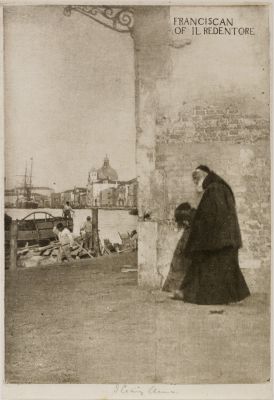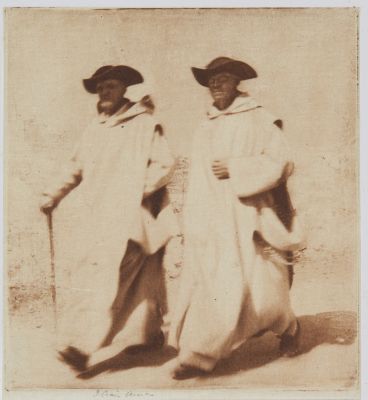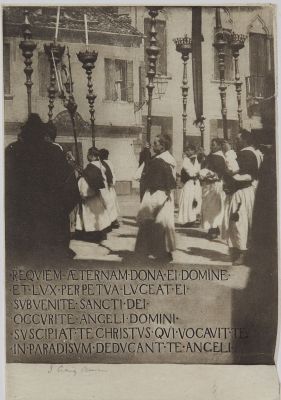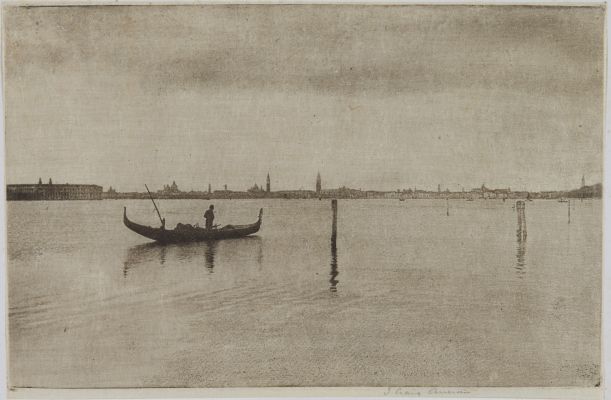
Title
A Franciscan, VeniceArtist
Annan, James Craig (Scottish, 1864-1946)Key FigurePublication
Venice and LombardyDate
1896Process
Photogravure (tissue)Atelier
James Craig AnnanImage Size
9.5 x 15 cm
In 1884 James Craig Annan explained that to capture the Franciscan he arranged and waited ‘fully’ half an hour with the whole composition arranged and without making an exposure, before the old gentleman in brown habit came along, and he is unaware of the great service he did me." [1]
This version was printed from a split negative. Close inspection proves that Annan notched together two negatives. The joint is hidden in the stone wall. Why Annan ‘composited’ an ‘instantanous’ image is not known and indeed seems contradictory. It does however reveal Annan’s propensity to thoroughly work the plate. The making of the negative is the first stage. While this initial operation requires great promptitude of action, the subsequent manipulation may be prolonged into a long-drawn-out pleasure. [2]
A Franciscan, Venice also has this deliberately designed aspect. In one version the wall above the monk is blank. In another ‘Franciscan of II Redentore’ appears where one might expect the name of the street. It is, instead, a name plate for the monk, telling us that he comes from II Redentore. A pioneering nod to the traditional art of engraving.
Since the early nineties James Craig Annan had been one of the chief forces in the development of pictorial photography. This portfolio of prints is his masterpiece. Limited to an edition of 75, the eleven plates include some of Annan’s most sophisticated and celebrated early work. The small photogravures masterfully etched and printed by Annan himself on Japan tissue and individually signed, explore for the first time the instantaneous moments accessible only to the camera combined with the control, art and craft of traditional etching. The tension between photography emulating painting and a truthful photography able to represent a new art form is clearly visible in Venice and Lombardy and reveals Annan’s ability to articulate the most advanced issues of his time. The portfolio, according to Ken Jacobson, contains signed, tiny, gem-like photogravures that might be seen as the precursor for the style of Camera Work – Stieglitz’s widely praised journal, vehicle of modern photography and photogravure tour-de-force. Stieglitz greatly admired Annan and was certainly influenced by this work.
A Franciscan is probably influenced in its composition by a photograph by David Octavius Hill, The House of Death, which is the portrait of the Scottish painter W. Leighton Leitch (Glasgow University Library, Glasgow). A painter and a pioneer of fine art photography, Hill was a close friend of Annan’s father Thomas Annan, and he was very much admired by Craig Annan himself who addressed his compositions as ‘of the noble order which only a great mind may conceive.’ Bologna
Reproduced / Exhibited
Stieglitz, Alfred, Richard Whelan, and Sarah Greenough. Stieglitz on Photography: His Selected Essays and Notes. New York, NY: Aperture Foundation, 2000. p. 168
Buchanan, William. J. Craig Annan: Selected Texts and Bibliography. Oxford: Clio Press, 1994. fig. 9.
Buchanan, William, and J C. Annan. The Art of the Photographer: J. Craig Annan, 1864-1946. Edinburgh: National Galleries of Scotland, 1992. Fig. 10.
Harker, Margaret F. The Linked Ring: The Secession Movement in Photography in Britain, 1892-1910. London: Heinemann, 1979. pl 9.2
Jeffrey, Ian. Photography: A Concise History. London: Thames and Hudson, 1981. no. 52
Naef, Weston J. The Collection of Alfred Stieglitz: Fifty Pioneers of Modern Photography. New York: Viking Press, 1978. no. 22.
References
[1] [2] Buchanan, William. J. Craig Annan: Selected Texts and Bibliography. Oxford: Clio Press, 1994. fig. 9. P. 8 and p 83
Bologna, Gabriella, ‘The Aesthetics of British Photography. A Case Study: James Craig Annan’s Portfolio Venice and Lombardy’ in Anon. 2013. Aesthetic Lives : ‘New Experiences New Subjects of Poetry New Forms of Art’. High Wycombe Bucks England: Rivendale Press











